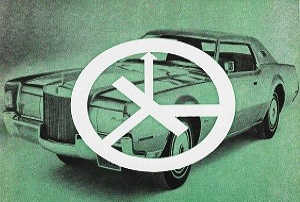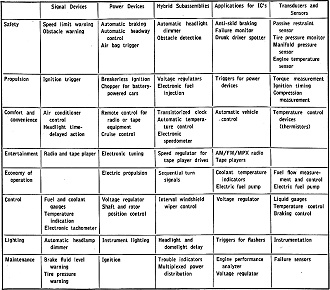|
April 1972 Popular Electronics
 Table of Contents Table of Contents
Wax nostalgic about and learn from the history of early electronics. See articles
from
Popular Electronics,
published October 1954 - April 1985. All copyrights are hereby acknowledged.
|
It is well known that American
automobile manufacturers really dropped the quality ball in the mid-1970s through
about 1990. Foreign car makers were gaining increased access to domestic markets
with designs that had more efficient engines and transmissions with superior materials
and techniques, and corrosion control was much better than most American cars that
often began to exhibit rust bubbles underneath the paint within a year or two -
particularly in regions where roadways were salted for controlling ice and snow.
People (like me) who bought used cars were leery about a vehicle with more than
70k-80k miles on them because it was almost guaranteed that a major engine or transmission
repair would not be far off. Foreign cars, in contrast, were still going strong
at 100k miles. If you were there, you know of what I speak. I mention that background
to help explain the opening statement in this 1972 Popular Electronics
magazine article describing what could be expected in the near future with electronics
in cars and trucks. A look at the one drawing reveals that by now everything predicted
is now standard equipment even on low-end cars, and of course not many people would
have predicted GPS navigation, Bluetooth-connected tire air pressure sensors, satellite
radio, or even air bags.
Solid State columns: April 1967,
August 1967,
April 1966,
August 1970,
July 1971,
October 1971,
April 1972.
More Solid-State Electronics for the New Cars
 What Ford and Chrysler are Offering in their
1972 Lines What Ford and Chrysler are Offering in their
1972 Lines
By John D. Drummond
Part 2
Chances are that the first car you drive with an on-board minicomputer that starts
the engine, optimizes ignition and air/fuel mix, sets safety mechanisms, and gets
ready to shift transmission, will come from Japan or Germany. The reason such a
car is not likely to come from Detroit is that foreign car firms and electronics
companies are cooperating with each other to develop and deliver sophisticated system
packages. The picture on the domestic front is quite different; a lack of good communications
has put the auto men and electronics men at odds with each other.
There is certainly no lack of expertise or ambition in the U.S. The missing ingredients
are cooperation and understanding. But with no clear, enthusiastic agreement, solid-state
electronics in American-made automobiles has only inched along.
It is obvious that any little "blackbox" electronic package integrated into an
automobile must be able to outfox and outlast the hostile environments created by
rough roads, snow, ice, mud, extreme heat, and extreme cold. Otherwise, the highly
practical automobile engineer wants no part of it, according to Charles T. Mulcahy,
a Ford Motor Co. Engineer. He goes on to say, "If the engine won't start, the car
won't go; if the engine starts and the car is inoperative, the car won't move."
But consider this: the little black box has guided man to the moon and back in
spectacular form. Solid-state devices contain no inherent wearout mechanisms. In
fact, thanks to their proven reliability, solid-state devices and systems are perhaps
the only practical and economical way to realize safety, environmental cleanliness,
and the convenience required for tomorrow's automobile.
 The Pressure is On. With enforcers
breathing down their necks, the auto makers are necessarily devoting most of their
efforts to solving the problem of reducing exhaust emissions and developing passive-restraint
devices to comply with Federal regulations. So, Detroit has had to lay aside, at
least for the present, development and implementation of such exotic things as a
single-wire multiplexed system that replaces the maze-like electrical network wiring
harness; radar-based anti-collision and braking systems; central processor to control
antiskid braking; electronic fuel injection; and speed and transmission controls. The Pressure is On. With enforcers
breathing down their necks, the auto makers are necessarily devoting most of their
efforts to solving the problem of reducing exhaust emissions and developing passive-restraint
devices to comply with Federal regulations. So, Detroit has had to lay aside, at
least for the present, development and implementation of such exotic things as a
single-wire multiplexed system that replaces the maze-like electrical network wiring
harness; radar-based anti-collision and braking systems; central processor to control
antiskid braking; electronic fuel injection; and speed and transmission controls.
The auto men are furious over this stringent Federal legislation. Ernest S. Starkman,
a General Motors vice president, explains that considerable progress has already
been made toward reducing air pollution from automobiles. But pressure for further
reductions is a consequence of impatience with the progress being made in the state
of the air in our urban environments.
This diagram shows various items being offered by Ford, though not all of them
are available on all Ford cars. The systems shown are all-electronic.
Whatever the impetus, the electronics industry has a golden opportunity to work
with Detroit in meeting Federal pollution standards. The electronics men feel that
solving both the pollution and passive-restraint problems are within their bailiwick.
Presently, however, the auto men are more preoccupied with grappling with the pollution
problem. But some electronic devices are showing up in Detroit's new cars.
 Possible Applications for Solid State in
Automobiles Possible Applications for Solid State in
Automobiles
Ford's Better Ideas. Typical of what is being marketed are the
electronic controls in Ford's 1972 line. Not all of the items (see illustration
below) are available in any one model. But they are available in various combinations
on all Ford-built cars.
Among the offerings are safety braking for skid control to prevent the wheels
from locking up and skidding should the driver attempt a panic stop on wet, slippery
or icy roads. The system utilizes an electronic computer that goes to work only
during an emergency situation that could cause the wheels to lock. The computer
receives speed information from a wheel sensor through a digital-to-analog (D-A)
converter that translates it to a dc voltage before it is fed to a differentiator
and data analyzer. The differentiator output is compared with a reference signal
representing the coefficient of friction of the road surface from the data analyzer.
The comparator output is fed to a logic circuit which determines the amount of braking
required and simultaneously activates a power stage which controls braking.
Automatic speed control is another offering. Using an electronic memory, this
system automatically maintains a constant speed in response to the driver's command.
When the car reaches cruising speed, the driver presses a button. The desired speed
is then "memorized" and maintained up- and downhill and on the straightaway without
the driver having to touch the accelerator. When the brakes are applied, the speed
control is automatically deactivated.
A number of safety features have been put into the system to meet the industry's
standards. For example, a redundant brake-disable feature is available to protect
against a defective or poorly adjusted brake switch. Hence, if no disabling signal
is received when the brake pedal is depressed, the speed control will automatically
disable when the car's speed drops to about 8 miles below the speed that was set
into the computer.
A distributor modulator is a third offering. Designed primarily as an exhaust
control device, the modulator precisely controls spark advance at speeds in the
25-32-mph range, assuring more complete fuel combustion.

Diagram of Ford's new anti-skid braking system installation.
Computer is located behind glove compartment. (Photo courtesy of Ford Motor Company.)
There is also an rpm limiter available. It is used primarily in Ford cars equipped
with high-performance engines and manual transmissions. This over-speed limiter
keeps the engine from exceeding a safe maximum rpm limit.
Chrysler's Coming Through. Keeping up with their Detroit rivals,
the Chrysler people are pushing electronics in their ignition systems, a safety
braking system, and automatic temperature control.
The electronic ignition, which eliminates breaker points, looks pretty much like
a conventional system except for a control unit between the distributor and the
ignition coil and the addition of a dual ballast resistor. The electronic circuitry
is activated by a pickup coil and is used to control a switching transistor that
opens and closes the primary circuit of the ignition coil.
The great advantage of the breakerless system is lower tune-up cost. A by-product
of the electronic circuitry, claims Chrysler, is that ignition timing and dwell
angle are more accurately controlled than would be possible with conventional breaker
points. The end result is better exhaust emission control.
Like the systems employed by GM and Ford, Chrysler's safety brake relies on a
logic computer to activate a pressure modulator to decrease the amount of hydraulic
pressure being applied to the brake at the wheel which is about to lock up or skid.
Where it differs from the competition is that the Chrysler system prevents front
or rear wheel lockup for shorter straight-line stopping distances. It is claimed
that the four-wheel safety braking system makes any driver better than an expert
driving a standard-equipped car in straight-ahead braking applications. However,
as Chrysler engineers are quick to point out, it cannot correct for skids initiated
by bad driving, such as when entering a curve too fast.
The 1972 Chrysler and Imperial model autos are equipped with a second-generation
automatic-temperature control which uses an all-electronic solid-state amplifier
to totally control the system's performance. In prior systems, Chrysler employed
a combination of vacu-electronic components to automatically adjust temperature.
This marks the first time that Chrysler Corp. has used a totally solid-state system
employing IC's, transistors, and diodes to control a major system.
The Coming Tide. It is obvious from the foregoing that, in spite
of foot-dragging and lack of cooperation, some inroads are being made by the electronics
industry in Car City. What is also obvious is that, if and when a team effort is
finally made, great things are in store for the average American-made automobile.
Let us hope that the animosity gap existing between the car makers and the electronics
industry narrows soon and creates the friendly conditions needed to bring about
cooperation.
Posted March 14, 2024
(updated from original post on 7/10/2017)
|




























 What Ford and Chrysler are Offering in their
1972 Lines
What Ford and Chrysler are Offering in their
1972 Lines 


